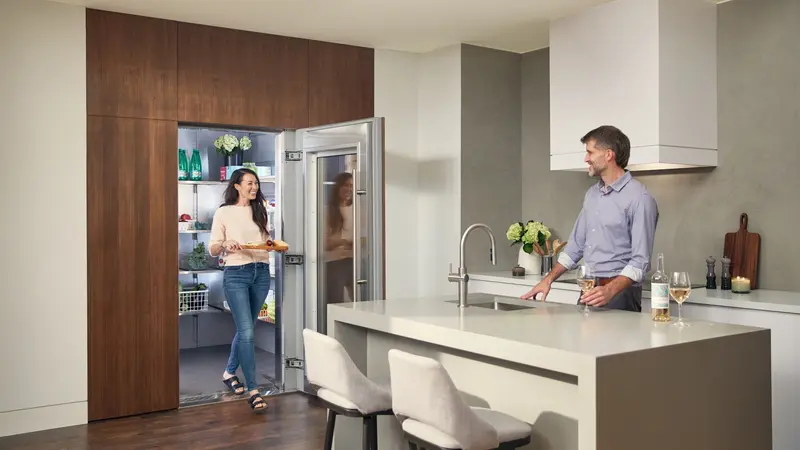In the world of commercial food storage, walk-in refrigerators, and walk-in freezers are essential to the success and safety of any food-related business. Whether you own a restaurant, grocery store, catering company, or another food service business, maintaining proper food temperatures is critical to ensure safety, reduce waste, and meet regulatory requirements. Both walk-in refrigerators and walk-in freezers are large, durable cold storage units that offer a versatile, efficient, and highly organized solution for managing your inventory.
In this comprehensive guide, we’ll delve into everything you need to know about walk-in refrigerators and freezers, from how they work to their importance in different industries, as well as key features, benefits, and things to consider when investing in one.
What Are Walk-in Refrigerators and Walk-in Freezers?
Walk-in refrigerators and walk-in freezers are large, enclosed storage units designed for cold storage of perishable goods. They are typically found in commercial kitchens, food service businesses, supermarkets, and other settings that require long-term cold storage. Unlike traditional refrigerators and freezers, which are limited in size, walk-ins allow for large-scale storage of items, providing the space necessary to keep food, beverages, or other perishable goods organized and safely stored at optimal temperatures.
Additionally, storage bins can be used within these walk-in units to further enhance organization and accessibility, making it easier to manage inventory.
- Walk-in refrigerators are designed to maintain temperatures just above freezing (typically between 35°F and 40°F). They’re used to store fruits, vegetables, dairy products, and other fresh goods that need to be kept cool but not frozen.
- Walk-in freezers, on the other hand, are designed to store frozen goods at sub-zero temperatures (usually -10°F to 0°F). These are used to store meat, seafood, and other items that require long-term freezing to maintain freshness.
Both units can be customized in terms of size, configuration, and features, making them an essential part of a commercial kitchen’s infrastructure.
Why Are Walk-in Refrigerators and Freezers Important?
1. Efficient Storage for Large Quantities
Restaurants, catering companies, and other food-related businesses often need to store bulk quantities of food. Walk-in refrigerators and freezers provide a much larger storage space compared to standard refrigerators and freezers, allowing businesses to store food items more efficiently. This means businesses can buy in bulk, which often results in cost savings, and minimizes the number of deliveries required.
2. Preservation of Food Quality
Proper food preservation is a top priority for any food business. Walk-in refrigerators and freezers maintain a stable temperature that ensures perishable goods remain fresh for extended periods. By preventing spoilage and maintaining the nutritional quality of food, businesses can reduce food waste and enhance the overall quality of their offerings.
3. Regulatory Compliance
Health and safety regulations in most countries require food service businesses to maintain food at specific temperatures to prevent bacterial growth. Walk-in refrigerators and freezers help ensure compliance with these regulations by keeping food at safe temperatures. Failure to comply with these standards can lead to fines, closures, or worse, foodborne illness outbreaks.
4. Increased Organization
With the ability to store large quantities of food, walk-ins allow for better organization of perishable items. This ensures that food items are easily accessible, reducing the time spent by employees searching for ingredients and improving overall efficiency in the kitchen.
Key Features of Walk-in Refrigerators and Freezers
When choosing a walk-in refrigerator or freezer, there are several important features and considerations to keep in mind. These features ensure the unit operates efficiently and meets your business’s specific needs.
1. Size and Customization
Walk-in refrigerators and freezers come in various sizes, ranging from small units that fit into compact spaces to large units that can store massive quantities of food. Many manufacturers offer custom-sized walk-ins to meet the specific space and capacity requirements of a business. It’s essential to assess how much space you have available and how much food you need to store to select the appropriate size.
2. Insulation
Proper insulation is critical for maintaining stable temperatures and energy efficiency. Walk-in units typically have thick insulation panels made from materials like polyurethane, polystyrene, or extruded polystyrene. Thicker insulation ensures better temperature retention, reducing energy consumption and keeping operating costs low.
3. Temperature Control
Walk-ins come with digital temperature controls that allow for precise management of internal temperatures. Advanced temperature control systems help ensure that the temperature remains consistent, preventing temperature fluctuations that could compromise food safety.
4. Doors and Seals
The door is a critical component of any walk-in refrigerator or freezer. It should have a strong seal to prevent cold air from escaping, which can affect temperature consistency and increase energy consumption. Many walk-ins are equipped with self-closing doors and airtight gaskets to ensure optimal performance. Additionally, heavy-duty hinges and locking mechanisms are essential for durability and security.
5. Flooring Options
Depending on the type of business and the weight of the items stored, you may need specific flooring for your walk-in unit. Many walk-ins are equipped with reinforced floors to support heavy loads. Some models may also come with anti-slip surfaces, ensuring safety for employees working inside the unit.
6. Lighting
Good lighting is essential in a walk-in refrigerator or freezer for safety and convenience. LED lighting is commonly used because it is energy-efficient and provides bright, even illumination without generating heat.
7. Energy Efficiency
Energy efficiency is an important consideration when investing in a walk-in unit, as these systems run continuously to maintain temperature. Look for models with Energy Star certifications, high-quality insulation, and efficient compressors that can reduce electricity usage and lower utility bills.
Industries that Rely on Walk-in Refrigerators and Freezers
1. Restaurants and Catering Services
Restaurants and catering companies are among the biggest users of walk-in refrigerators and freezers. They rely on these units to store a wide range of perishable goods, including fresh produce, dairy products, and frozen meats. The large storage space and customizable configurations make walk-ins indispensable for efficient kitchen operations.
2. Supermarkets and Grocery Stores
Supermarkets and grocery stores use walk-in refrigerators and freezers to store inventory before it’s placed on the sales floor. This includes meat, dairy products, frozen foods, and beverages. The ability to store large quantities of stock ensures the store can meet customer demands while minimizing food spoilage.
3. Bakeries
Bakeries use walk-in refrigerators to store ingredients like dairy products, eggs, and yeast, which are critical for baking operations. They also use walk-in freezers to store items like frozen dough, pastries, and other baked goods that need to be preserved for later use.
4. Floral Shops
In the floral industry, maintaining a specific temperature is key to preserving the freshness and longevity of flowers. Walk-in refrigerators are used by florists to store flowers and plants, ensuring they remain vibrant and fresh until they are sold or used in arrangements.
5. Medical and Pharmaceutical Industries
Walk-in refrigerators are not limited to the food industry. In the medical and pharmaceutical sectors, they are used to store temperature-sensitive drugs, vaccines, and biological samples. These industries rely on strict temperature controls to ensure product safety and efficacy.
Factors to Consider When Buying a Walk-in Refrigerator or Freezer
Investing in a walk-in refrigerator or freezer is a significant decision for any business. Here are a few key factors to consider when making your purchase:
1. Size and Layout
Consider the size of the space where the unit will be installed and the amount of food or items you need to store. If you have limited space, you might need to opt for a smaller, custom-sized unit. Think about the layout as well; you want a unit that is easy to access and navigate within your kitchen or storage area.
2. Temperature Requirements
Determine whether you need a refrigerator, a freezer, or both. Some businesses may benefit from a combination walk-in that includes separate refrigerated and frozen sections. Ensure the unit has accurate and reliable temperature controls to meet your specific needs.
3. Installation and Maintenance
Installation can be a complex process, especially for larger walk-ins. Make sure the unit can be easily installed in your building and that it complies with local building codes. Also, consider the maintenance needs of the unit. Regular cleaning and servicing are essential to ensure the longevity and performance of the walk-in.
4. Budget
Walk-in refrigerators and freezers can be a significant financial investment. While it’s important to stick to your budget, don’t sacrifice quality for cost. An energy-efficient, durable unit may have a higher upfront cost but will save you money in the long run through lower energy bills and reduced maintenance costs.
Conclusion
Walk-in refrigerators and walk-in freezers are an indispensable part of many businesses, from restaurants and grocery stores to bakeries and medical facilities. They offer the space, temperature control, and efficiency necessary to store large quantities of perishable items, helping businesses maintain food safety standards, minimize waste, and improve operational efficiency. By investing in the right walk-in unit and maintaining it properly, businesses can ensure that their inventory is stored in the best possible conditions, ultimately contributing to their success.



